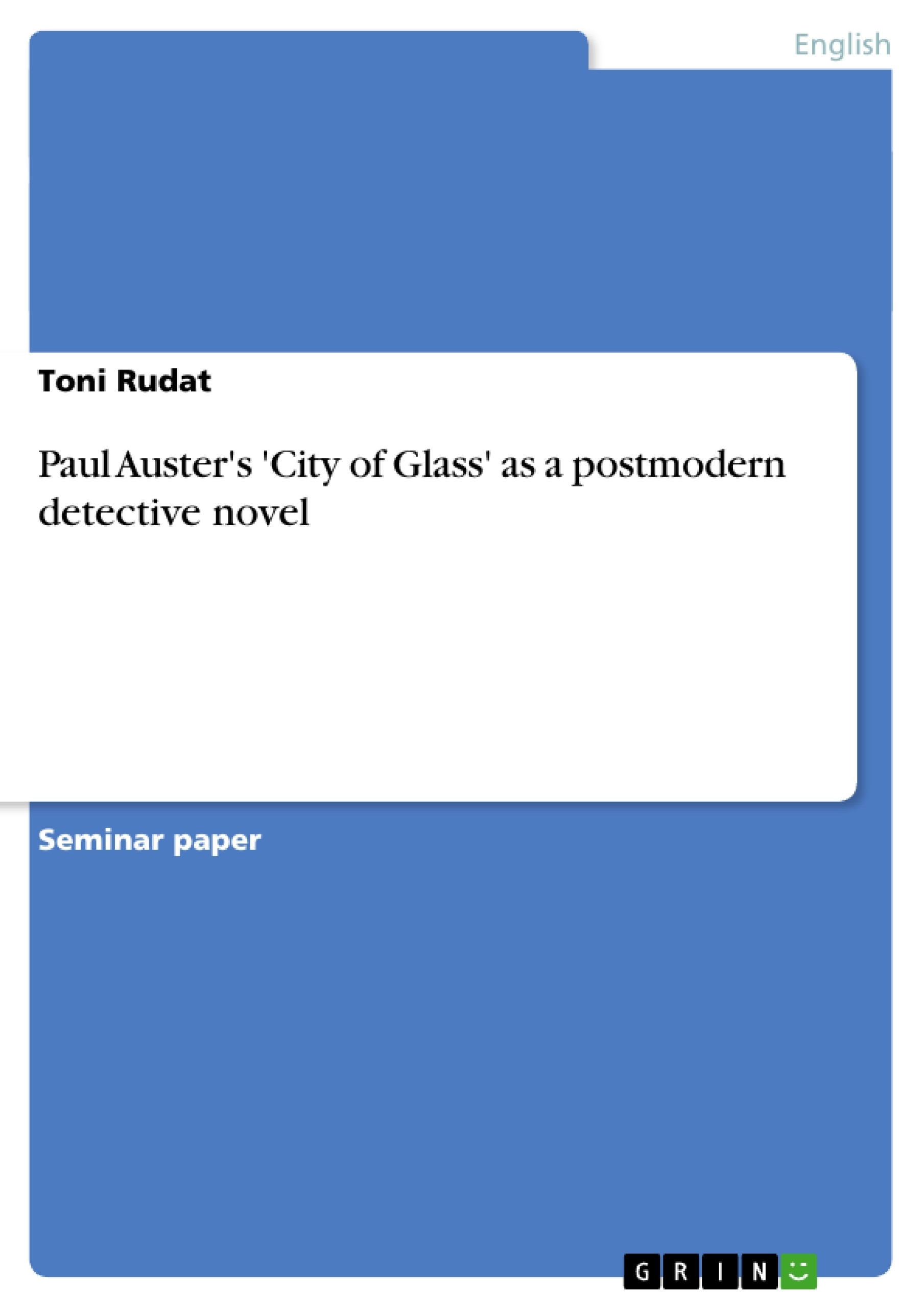PAUL AUSTER`s novel ′City of Glass′ published in 1985 appeared during the period of the postmodern era.1 Although it is considerably discussed at what time the beginnings of the postmodern era is to be set, it is irrefutable that ´City of Glass´ belongs to postmodern literature.
To analyse in how far PAUL AUSTER`s ´City of Glass´ serves as a representative of the postmodern era and to show the reader in what way postmodern qualities are converted into the writings of that time, the main part of this paper will be divided up into two sections. The first section serves to define the coming up of this movement and the qualities it possesses within the genre of detective fiction. Furthermore some important idealistic features like the idea of reality and identity have to be taken into consideration. The short introduction of the two identity-constituting models by ERIKSON and MEAD will provide a better overview of the idea of identity formation. Within the second section the novel itself will be taken into consideration. Therefore it is necessary to take a close look at the main character Daniel Quinn and his character development the crisis of his identity in the course of the novel respectively. Besides another striking factor, namely the appearance of doublings and triplings of characters, has to be clarified as well as the role of the narrator. The conclusion at the end of the paper is supposed then to show to what extent ´City of Glass´ belongs to postmodern literature and which peculiarities of postmodern writings have been included in this novel.
Since there are just a few recent publications on Paul Auster and his novels three of them namely, An Art of Desire: Reading Paul Auster by BERND HERZOGENRATH, Crisis: The Works of Paul Auster by CARSTEN SPRINGER and the publication of ANNE M. HOLZAPFEL The New York Trilogy: Whodunit?: Tracking the Structure of Paul Auster′s Anti-Detective Novels served as the basis for this paper.
Inhaltsverzeichnis (Table of Contents)
- 1.0 Introduction
- 2.0 Introduction to postmodern detective fiction
- 2.1 The question of reality and identity within the postmodern period
- 2.2. Eriksson's model of identity formation
- 2.3 Mead's model of identity formation
- 3.0 Daniel Quinn: a multiple character
- 3.1 The quality of doublings within the novel
- 3.2 The narrator's role within the novel
- 4.0 Conclusion
- 5.0 Bibliography
Zielsetzung und Themenschwerpunkte (Objectives and Key Themes)
This paper aims to explore the postmodern qualities present in Paul Auster's novel "City of Glass" and analyze its position as a representative of the postmodern detective fiction genre. It examines how the novel's narrative structure and themes reflect the characteristics of postmodernism.
- The concept of reality and identity in postmodernism
- The role of the detective in postmodern detective fiction
- The exploration of multiple identities and doublings in the novel
- The significance of the narrator in shaping the narrative
- The postmodern rejection of absolute truth and the embrace of indeterminacy.
Zusammenfassung der Kapitel (Chapter Summaries)
- Chapter 1.0 Introduction: This chapter provides an overview of Paul Auster's novel "City of Glass" and its context within the postmodern era. It establishes the main objectives of the paper and introduces the key themes that will be explored in subsequent chapters.
- Chapter 2.0 Introduction to postmodern detective fiction: This chapter delves into the definition and characteristics of postmodern detective fiction. It examines the concept of reality and identity in postmodernism, exploring the models of Erik Erikson and George Herbert Mead. The chapter also discusses the emergence of postmodernism as a cultural turn and its impact on literary expression.
- Chapter 3.0 Daniel Quinn: a multiple character: This chapter focuses on the main character of the novel, Daniel Quinn, analyzing his character development and the crisis of identity he experiences. It explores the significance of doublings and triplings of characters within the narrative and the role of the narrator in shaping the story.
Schlüsselwörter (Keywords)
Key concepts explored in this paper include postmodernism, detective fiction, identity, reality, narrative structure, doublings, narrator, anti-detective fiction, indeterminacy, and the works of Paul Auster. The analysis focuses on "City of Glass" and its portrayal of the postmodern world, as well as the evolution of the detective genre in a postmodern context.
- Quote paper
- Toni Rudat (Author), 2006, Paul Auster's 'City of Glass' as a postmodern detective novel, Munich, GRIN Verlag, https://www.grin.com/document/58355



